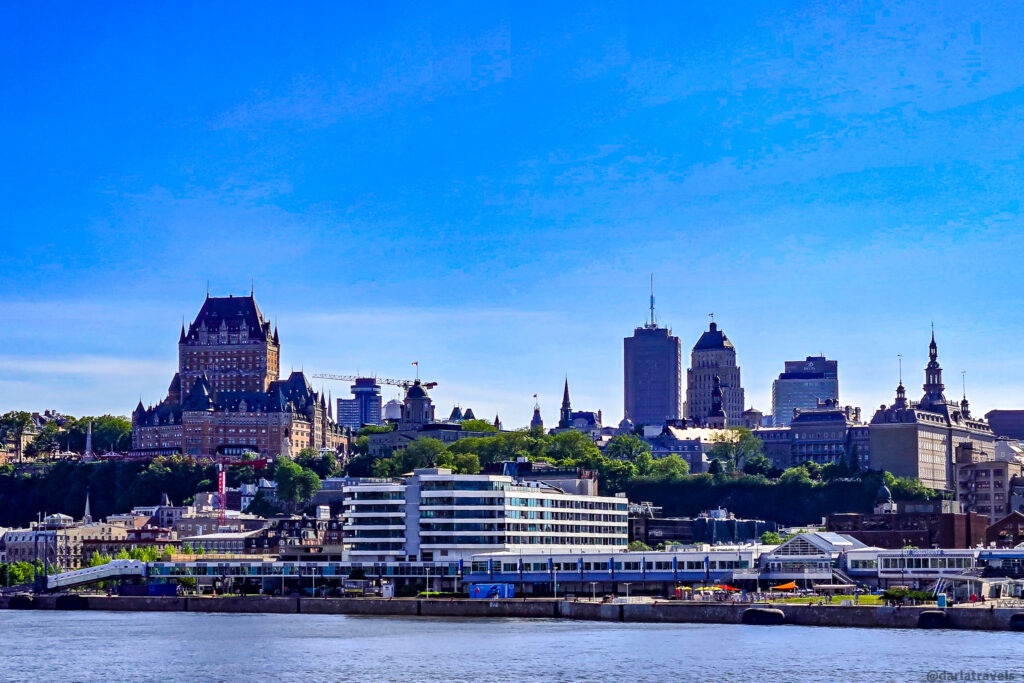
It seems every traveler wants to experience Québec City’s Old World charm and European vibe, and for good reason. The medieval-style city gates, the cobblestone streets, the historic squares, and the imposing Château Frontenac are “must-sees.”
But Québec City is chock full of history and meaning beyond its prominent landmarks. Another layer of the city reveals natural beauty, hidden history, and buried architecture, allowing you to experience Québec’s story from a fresh perspective.
If you’ve already seen the big sights and are ready to dig deeper, here are three “off the beaten track” experiences that reveal the city’s secrets — from an underground history site to an archaeological center built on centuries of ruins, to a river cruise that shows Québec from its most majestic angle.
** Darla Travels is reader-supported.
When you buy through our links, we may earn a commission. **
Book your Off the Beaten Track Activities in Québec City
- 🏰 Québec City: Saint Louis Forts and Châteaux visit
- 🛥️ Québec City: Guided Sightseeing River Cruise
- 🛥️ Québec City: 3 or 5-Course Dinner Cruise with DJ & Dancing
- 🛥️ Québec City: Evening Cruise with Live DJ
- 🛥️ Québec City: Weekend River Brunch Cruise
- 🛥️ Québec City: 2-Hour Cocktail & DJ Evening Cruise
🏨 And find a great place to stay in Québec at
Beneath the Terrace: Saint-Louis Forts and Châteaux National Historic Site
Most visitors to Old Québec stroll the broad Dufferin Terrace (Terrasse Dufferin) to view the Saint Lawrence River and the Château Frontenac. But do they realize that just beneath their feet lie the remains of the residences of Québec’s original governors?
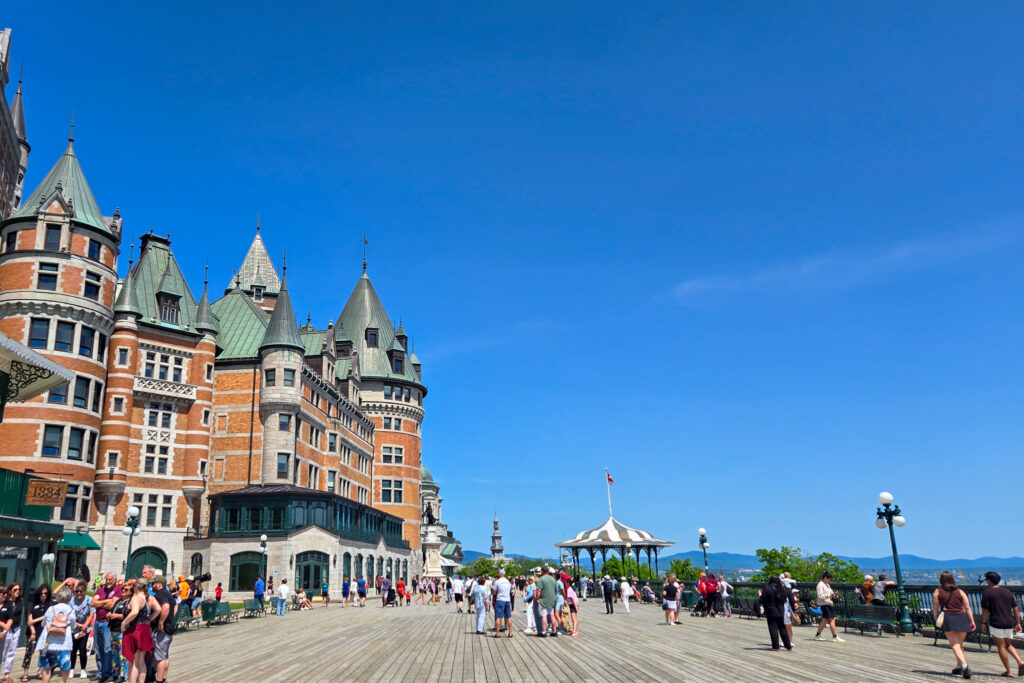
Hidden in plain sight under the beaten track, the Saint-Louis Forts and Châteaux National Historic Site preserves the archaeological foundations of the residences and offices where French and later British governors ruled the colony.
It’s a rare chance to step back into the earliest days of North American history, and it’s right underneath the bustle of modern Québec City.
A Short History of the Saint-Louis Forts and Châteaux
Samuel de Champlain built a wooden fort, which he named Saint-Louis, at this site at the top of Cap Diamant (Cape Diamond) in 1620. He also founded the first permanent French settlement in North America. From there:
- 1626. A stone residence is built, and the fort is improved.
- 1648. Charles Huault de Montmagny, the first official governor of New France, enlarges the building, and it becomes the Château Saint-Louis. The original Château was one story and about 1955 square feet (18.1 square meters).
- 1723. Governor Frontenac completes a new fortified Château Saint-Louis. Four times larger than the original, it was two stories tall and had lateral wings.
- 1759. This Château sustains damage from the British forces during the Battle of Québec. Only portions of the Château could be salvaged and restored.
- 1808-1811. British Governor James Craig enlarges and modernizes the building with popular architectural features and also adds a third story.
- 1834. A fire in January destroys the Château. It was never rebuilt.
From the 1600s through the 1800s, from the original fort to the final Château, this location was the administrative center of New France and, after the British conquest, the Province of Québec. Decisions made here shaped the continent. The Château also served as a social center for the city’s upper class, with many banquets, receptions, and plays held there by the governors.
The National Historic Site
Thanks to major archaeological digs, you can now descend below the Dufferin Terrace into a carefully excavated and preserved space housing the remains of the forts and Châteaux.
Walkways lead visitors through centuries of history, enhanced by interpretive panels and displays of recovered artifacts. The recovered items include fragments of pottery, tools, and architectural remains.
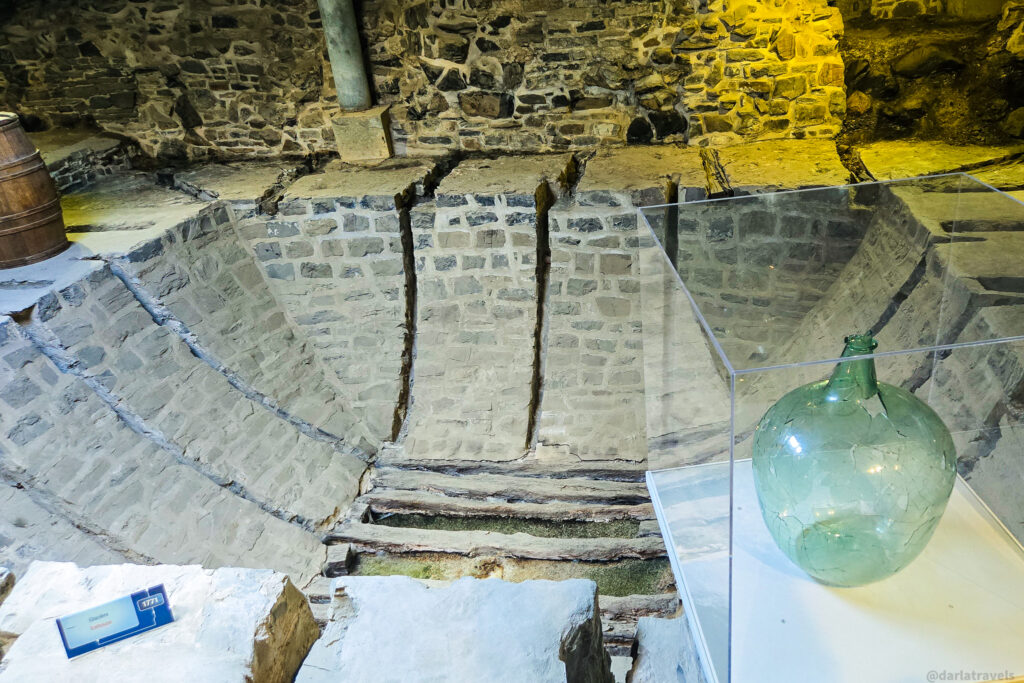
You’ll see stone walls, fireplaces, kitchens, and cellars. Food storage and preparation areas reveal the reality of working conditions in colonial times.
Admission tickets include a guided tour, which is highly recommended. My tour guide was extremely knowledgeable about the history of the forts and châteaux. He pointed out details of the ruins that are easy to overlook. And his explanations offered insights that made the site more alive and engaging.
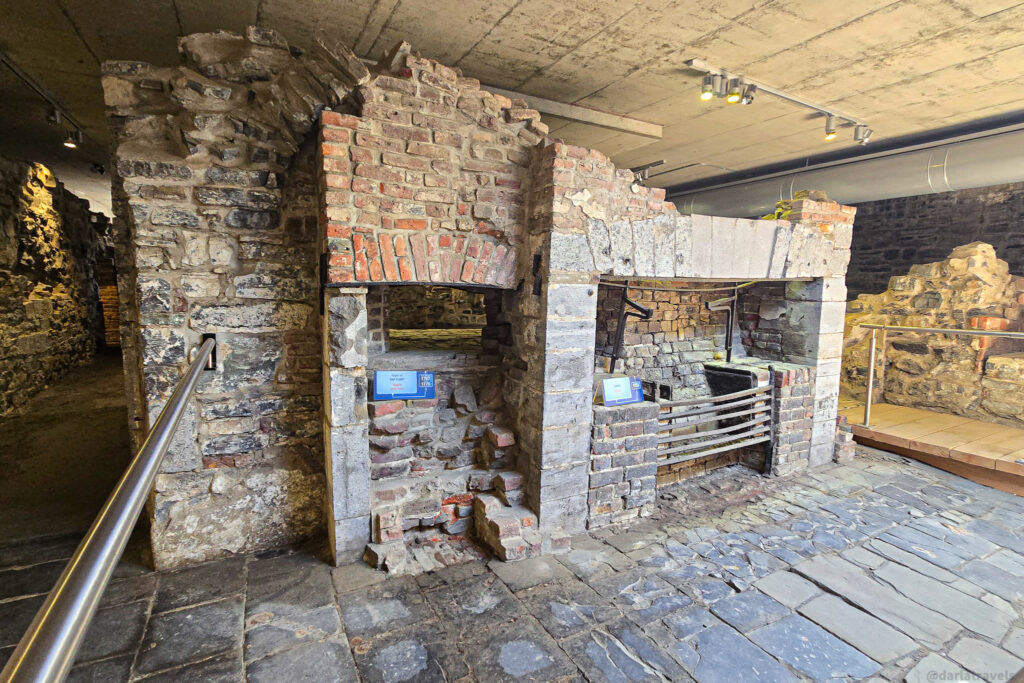
Practical tips for visiting the Saint-Louis Forts and Châteaux National Historic Site:
The Saint-Louis Forts and Châteaux are open from mid-May to mid-October. Admission tickets include a guided tour.
Confirm the seasonal opening hours and tour times, and allow about 45–60 minutes for your visit.
Purchase tickets online (be sure to select a tour given in your preferred language) or at the Frontenac kiosk on the Dufferin terrace. Adult admission is CAD$12 with discounts for seniors and children.
A self-guided audio tour is also available on the Parks Canada app.
Québec City from the Water: A Scenic Cruise on the AML Louis Jolliet
To get a broader perspective of Québec City’s setting, you need to see it from the river. So get off the beaten path of old Québec City’s crowded streets and onto the water with a cruise aboard the AML Louis Jolliet. This 1,000 passenger vessel features four decks, three outdoor terraces, multiple dining rooms, bars, and even dancefloors (although not all areas may be available on all cruises).
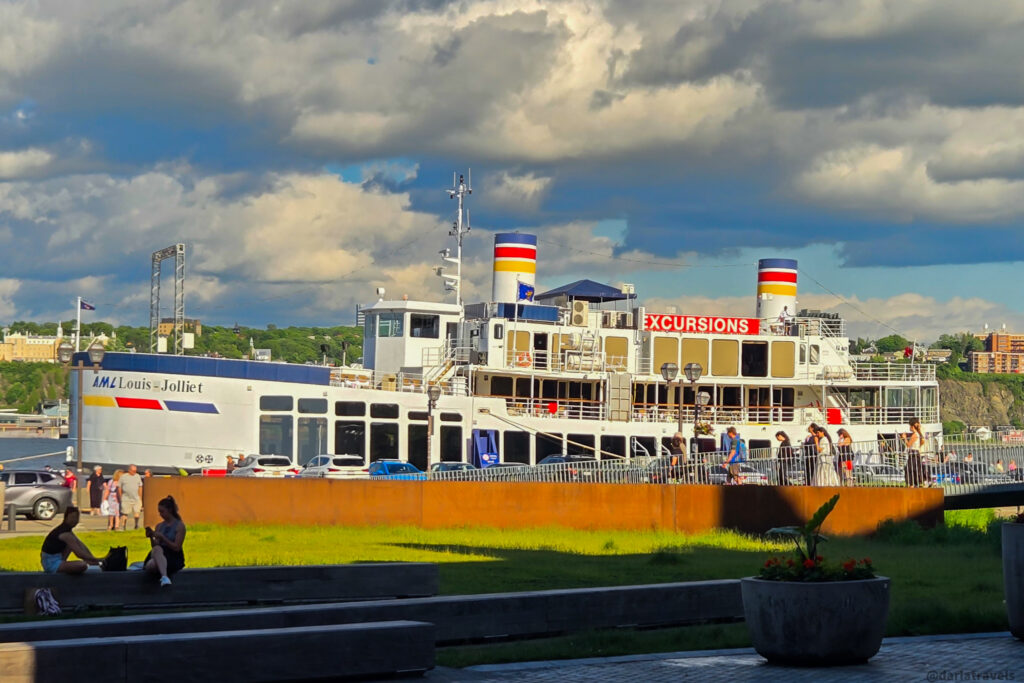
The boat’s namesake, French-Canadian explorer Louis Jolliet (b. 1645), explored and mapped the Upper Mississippi River in 1673 (along with Jesuit priest Jacques Marquette).
Highlights of the Guided Scenic Cruise on the Louis Jolliet
Let the Louis Jolliet take you on a 90-minute guided sightseeing river cruise. Gliding along the picturesque Saint Lawrence River showcases views of the natural landscape of Québec City, starting (and ending) at the base of the cliffs of Cap Diamant (Cape Diamond).
An expert guide provides commentary on the surrounding landscape, centuries of maritime and colonial history, and local culture. You are free to move about the boat to get a better view as the cruise proceeds.
Highlights of the cruise include water views of old Québec, including the imposing Château Frontenac.
On this cruise, you can see the Laurentian Mountains in the distance. They run along the northern coast of the Saint Lawrence River from Québec to the province of Labrador over a distance of approximately 900 miles (1,448 kilometers). They are among the oldest peaks in the world.
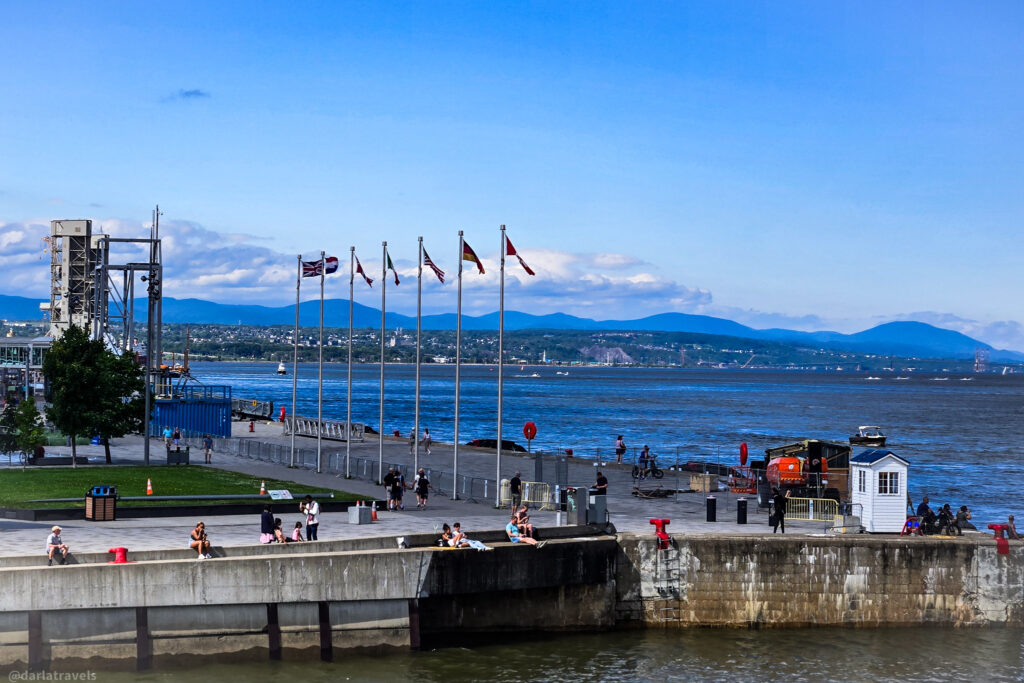
Across the Saint Lawrence River, near the Québec-Lévis ferry terminal, look for the Davie Shipyard National Historic Site of Canada. The wooden shipbuilding facility was established in 1829 and operated continuously as a shipyard until 1989!
That island in the middle of the Saint Lawrence River? It’s the Île d’Orléans, a National Historic Site of Canada since 1990.
Known as the “Cradle of French America,” it has a long history of permanent French colonies. Its thriving agritourism sector produces a variety of products, including fruits, vegetables, wine, cider, cheese, and maple products. It is also known for its blackcurrant liqueur and artisanal crafts.
The Orleans Island Bridge (Pont de l’Île-d’Orléans) is a 2.75-mile (4.43-km) long suspension bridge spanning the Saint Lawrence River, connecting the mainland with the island. The boat maneuvers under this impressive bridge to allow passengers to get the best views of the Montmorency Falls (Chute Montmorency) before turning back toward the port.
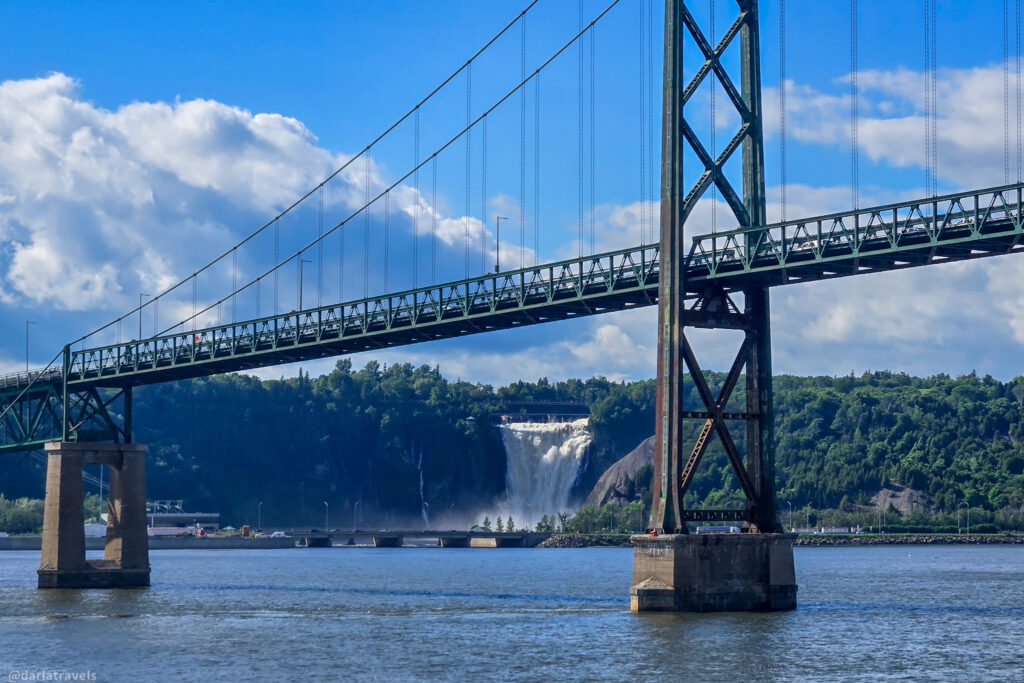
Montmorency Falls is a majestic 272-foot (83 m) tall waterfall on the coast of the mainland and is approximately 151 feet (46 meters) wide.
For a stunning waterfall hike near Québec City, read our article on How to hike to Delaney Falls (Chute Delaney).
Practical Tips for Enjoying a Scenic Cruise on the AML Louis Jolliet
Pick the right cruise for you. AML Croisières (AML Cruises) offers Louis Jolliet cruises with different themes and amenities, like meals, music, and dancing. Check out the options below:
- Guided Sightseeing River Cruise (90 minutes, described here)
- 3 or 5-Course Dinner Cruise with DJ & Dancing (3.5 hours)
- Evening Cruise with Live DJ (2 – 3.5 hours)
- Weekend River Brunch Cruise (2.5 hours)
- 2-Hour Cocktail & DJ Evening Cruise (2 hours)
Cruises depart from the Chouinard Pier (Quai Chouinard, 10 Dalhousie Street). Check in at the ticket booth at Chouinard Pier before departure to exchange your online voucher for a boarding pass.
Check the boarding time on your ticket and don’t be late-the boat will not wait for you!
Parking near the pier is limited. Plan on arriving early to find a spot, or take public transportation–several public buses (RTC) make stops at the dock.
Layers of the Past: L’Îlot des Palais (Intendant’s Palace)
A short walk from the Chouinard Pier and the Old Port, near the Québec City Train Station (Gare du Palais), an underappreciated treasure trove awaits — one that tells Québec City’s story from the ground up and from the beginning. The L’Îlot des Palais (Intendant’s Palace) is outside of the main tourist area and off the beaten path–but it wasn’t always that way.
Part museum and part archaeological site, the Palace is an open time capsule. In total, over 65 archaeological excavations have been conducted here.
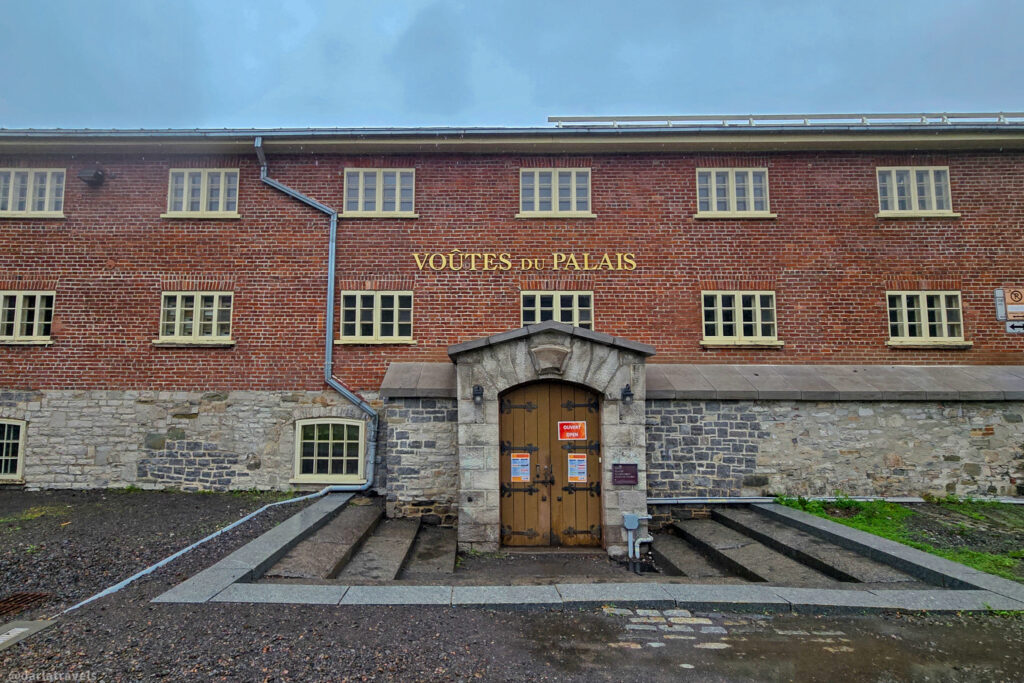
It’s called the Intendant’s Palace because three palaces were built at this site to house the Intendants of New France. The Intendant was a position second only to the governor. He was responsible for the civil side of government, including settlement and economic development, as well as the administration of justice.
A Short History of the L’Îlot des Palais Site
The land has undergone massive changes and shifts, as evidenced by the archeological excavations in this area. Different uses for the land include use and occupation by indigenous peoples before the arrival of Europeans. Stone tools, among other evidence, have been found at the site. Some notable dates include the following:
- 1666. Euro-Americans occupy the land
- 1667. The first Intendant, Jean Talon, begins building a brewery known as the Brasserie du Roy. Talon misjudges the economic impact of the brewery, and production halts in 1675.
- 1684. The brewery building becomes the first palace when it is turned into an official residence for Intendant Jacque De Meulles. It also includes the King’s Stores and a prison. Additionally, it hosts the Sovereign Council (similar to a parliament) of the colony.
- 1713. Fire destroys the palace on January 5.
- 1715. Construction of the second palace.
- 1725. Fire destroys the second palace.
- 1726. The palace is rebuilt (the third palace).
- 1759. The third palace survives the British siege of Québec.
- 1775. The palace was destroyed during the Continental Army’s attempted invasion of Québec City at the start of the American Revolutionary War. The site was subsequently abandoned.
- Following Years. The area was repurposed for civilian use as individuals acquired parts of the land from the British government. For example, the archaeological remains include a malt factory and the Clearihue bakery.
- 1852. Brewer Joseph Knight Boswell acquired land at the site of the palaces to expand his brewery. The Boswell Brewery operated until 1968.
- 1982. Archeological excavations commence at the site.
- 2006-07. New archaeological work commences in preparation for festivities on the 400th anniversary of the founding of Québec in 1608.
Inside the Intendant’s Palace Archaeological Center
The vaulted cellars that were used for food and wine storage in the second and third palaces are incorporated into the archaeological center. This museum houses permanent exhibitions of artifacts retrieved from the archaeological digs.
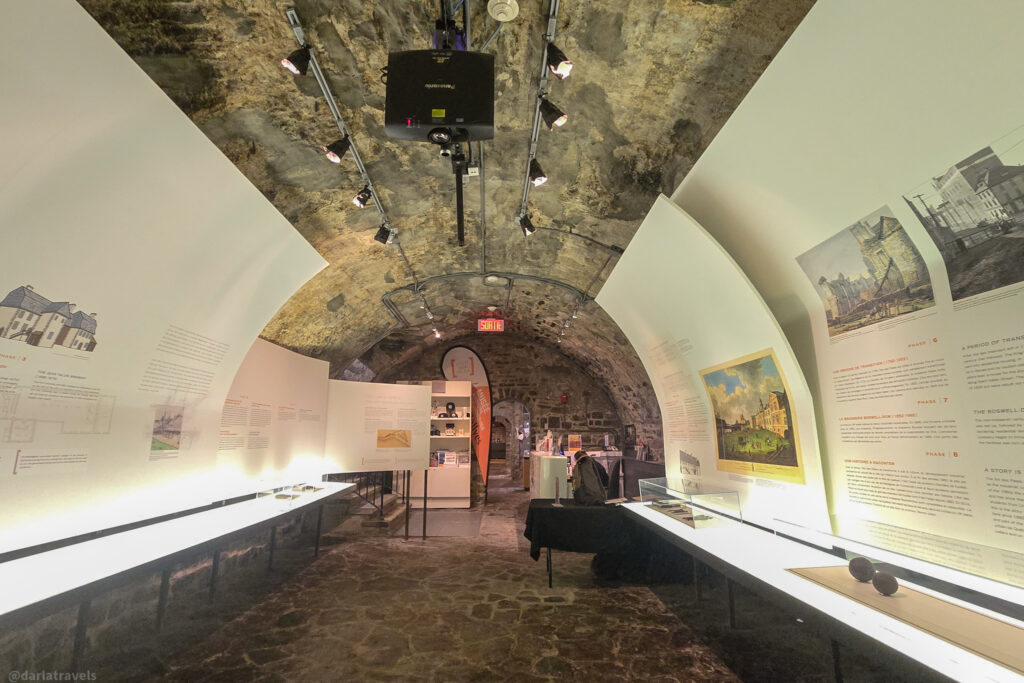
An immersive exhibition titled Ilot des Palais: Revelation showcases recovered artifacts from the archaeological excavations.
The exhibition named Here, We Brewed Beer! focuses on artifacts and memorabilia from the Jean Talon brewery era, as well as the later Boswell Brewery (renamed the Boswell-Dow Brewery after a sale and merger).
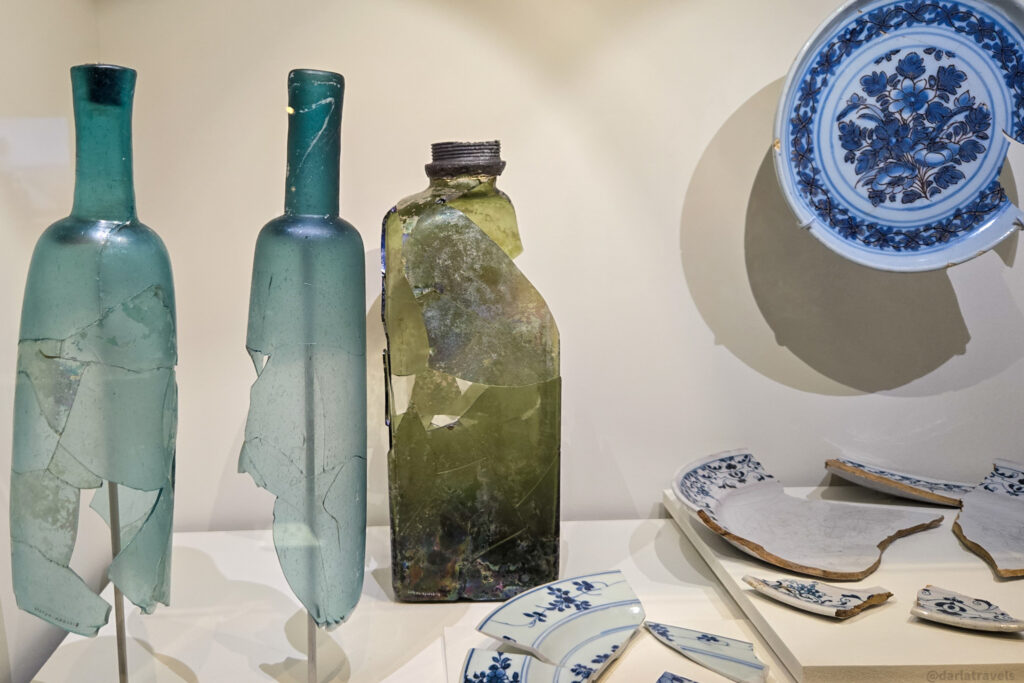
Finally, the short film 100 Years of Nightlife in Québec City is quite well done and entertaining. It recounts the history and stories of bars and musical venues in Québec City spanning the last century.
L’Îlot des Palais is one of those places that even some locals have yet to visit. It’s a reminder that Québec’s history isn’t just preserved in its monuments — it’s buried beneath our feet, waiting to be rediscovered.
Practical Tips for Visiting the L’Îlot des Palais
The L’Îlot des Palais is located on Rue Vallière, just north of Old Québec’s fortifications. The museum is open year-round and has extended hours during the primary tourist season.
Buy tickets at the museum. Admission is CAD$8 for adults with reduced prices for children, seniors, and students.
Find Your Stay in Québec City
Québec City has an astounding number and variety of accommodations in the tourist areas.
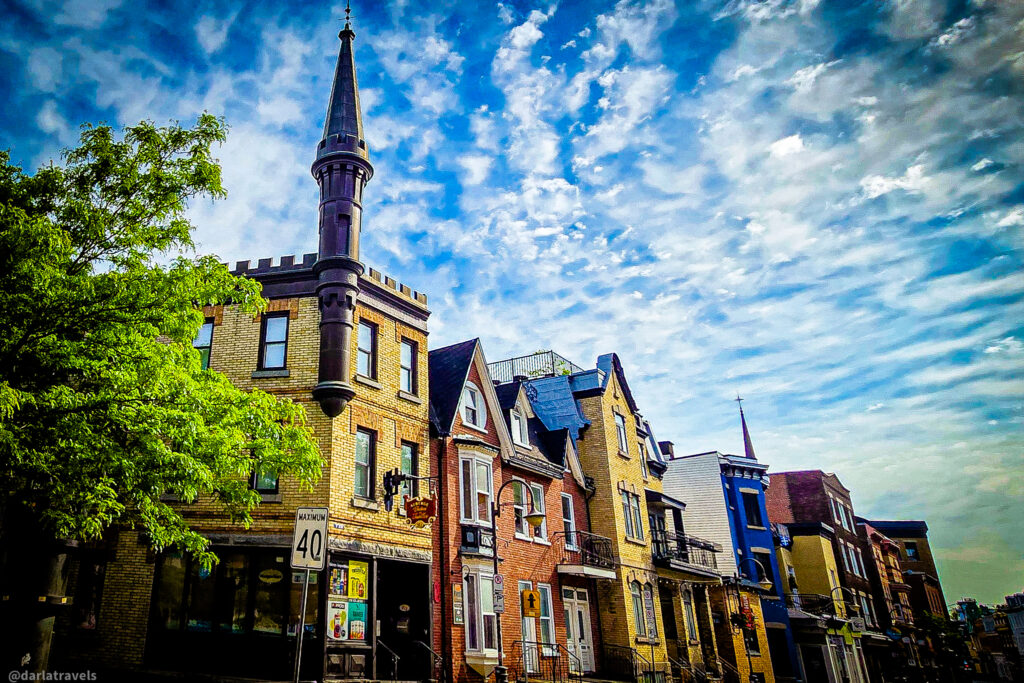
For example:
- Luxurious and Iconic: Fairmont Le Château Frontenac
- Cozy converted house with a turret!: Auberge Château Des Tourelles
- Comfortable Rooms with a saltwater pool and hot tub: Hotel Chateau Laurier Québec
- Budget Hostel with beautiful and spacious common areas and complimentary breakfast: Auberge Internationale de Québec – HI CANADA
For other options, use the map and links below to research and book your lodging in Québec City.
Book at Booking.com 🔷 Book at Expedia 🔷 Book at Hotels.com
Exploring Québec City: Pin It for Later!
I created these pins on Québec City’s “Off the Beaten Path” attractions for your Pinterest Boards.
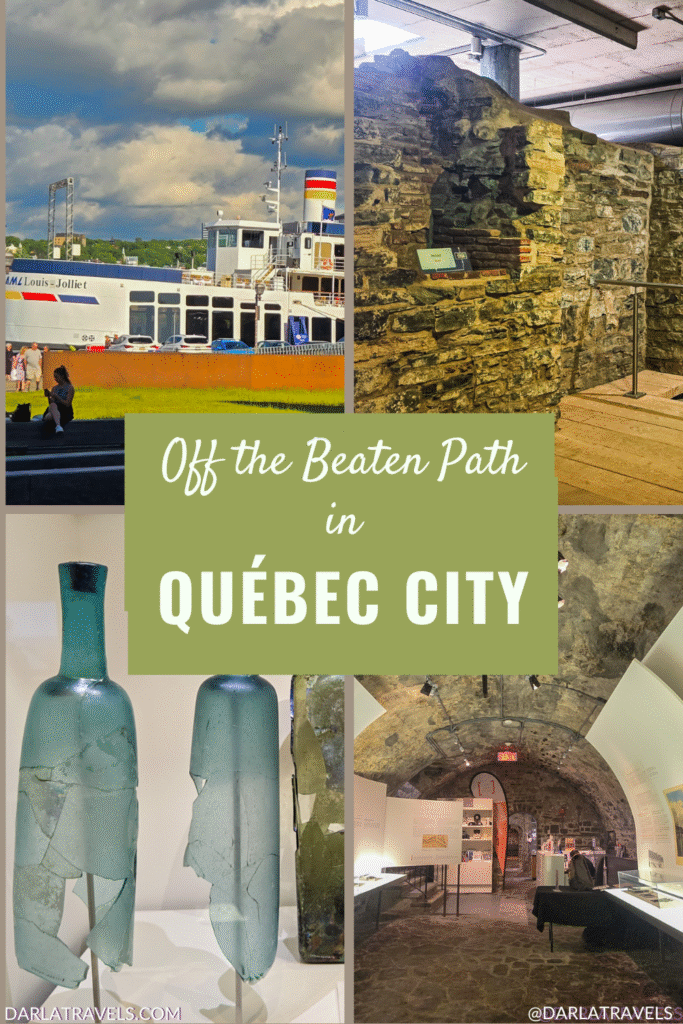
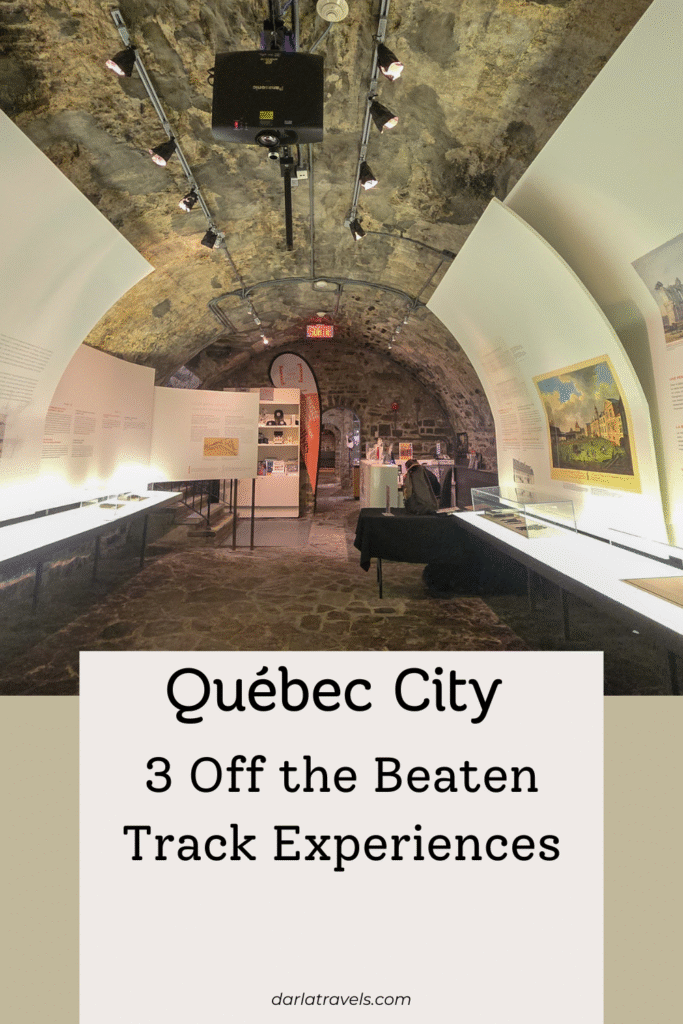
Final Thoughts on Seeing Québec City “Off the Beaten Path”
Québec City’s charm is undeniable. But beyond the significant landmarks, this old city’s long and complex history is revealed off the beaten track. Exploring the Saint-Louis Forts and Châteaux beneath Dufferin Terrace and uncovering the archaeological layers of L’Îlot des Palais together hint at the long and complex history of Québec City.
And cruising the Saint Lawrence aboard the Louis Jolliet provides a richer understanding of how and why Québec City formed at this spot.
Each site tells a different story: one buried, one floating, one built upon the past. So next time you wander through Old Québec, take a moment to look beyond the familiar postcard views. The city’s most fascinating secrets are often just off the beaten path, ready to surprise and enchant you.
Love these off the main tourist track ideas. The Intendant’s Palace archaeological center looks like something we’ll really enjoy when we visit.
Glad that you liked the idea!
Such an inspiring post! Québec City already feels magical, but going beyond the classic sights and uncovering its hidden layers makes it even more fascinating. I love the idea of exploring what’s beneath the Dufferin Terrace — I had no idea so much history sits right under that walkway. The underground site, the archaeological center, and the scenic river views sound like an amazing way to see the city from a fresh angle. Definitely adding these off-the-beaten-path experiences to my list for my visit!
Thank you-so glad you enjoyed the post!
I haven’t been to QC in many years. This makes me want to return! The practical tips are so helpful!
Glad you enjoyed the post!
Love being taken off the beaten tourism track, historical insights, and practical tips! I’ve always thought that Quebec must be Canada’s most interesting province (but l could do without those brutal winters).
Thank you! I went in June so no winter weather (although there was some rain).